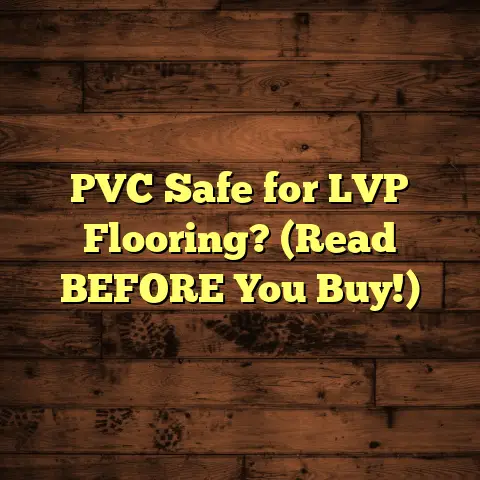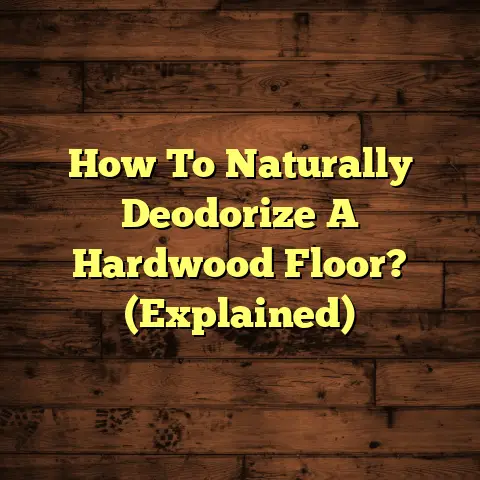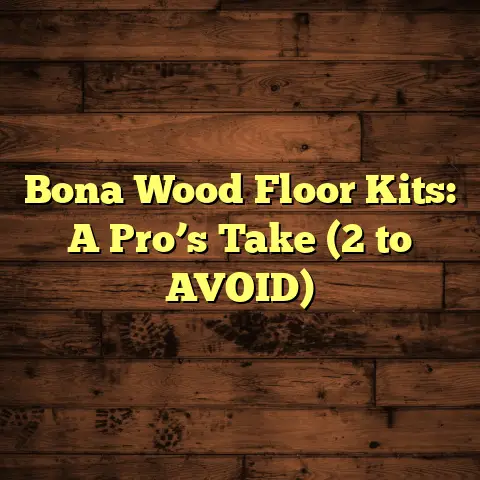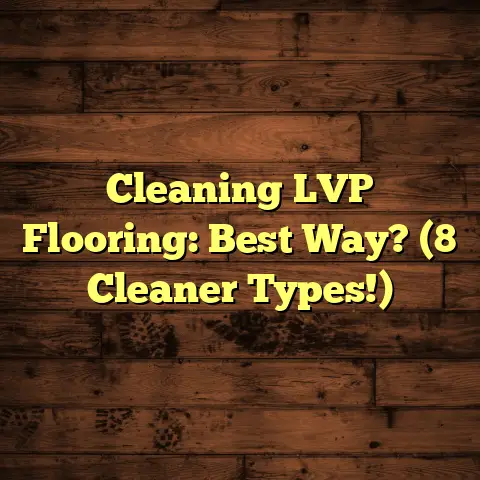Can You Buff Epoxy Floors? (2 Buffing Rules To Follow!)
Do you remember those days as a kid, skidding across the linoleum in your grandma’s kitchen?
Or maybe the glossy, almost-too-perfect epoxy floor in your dad’s garage, where he tinkered with cars?
Floors weren’t just floors then; they were stages for our lives, silent witnesses to laughter, spills, and countless memories.
Fast forward to today, and epoxy floors are all the rage!
From sleek modern homes to bustling commercial spaces, everyone’s loving their durability and that super cool, customizable look.
But here’s the big question I get asked all the time: “Can you buff epoxy floors?”
Well, grab a seat, because we’re about to dive deep into the world of epoxy, buffing, and keeping those floors looking fantastic for years to come!
Section 1: Understanding Epoxy Floors
Definition and Composition of Epoxy Floors
So, what exactly is epoxy flooring?
Think of it as a super-strong, super-shiny coating that’s applied over concrete (or sometimes other surfaces).
It’s made up of two main parts: epoxy resin and a hardener.
When these two mix, they create a chemical reaction that results in a rigid, durable plastic material.
There are several types of epoxy flooring systems out there, each with its own unique purpose:
Self-Leveling Epoxy: This creates a smooth, seamless surface, perfect for garages, showrooms, and even some residential spaces.
Epoxy Mortar Floors: The heavy-duty option, ideal for high-traffic areas and industrial settings.
Quartz-Filled Epoxy: Combines epoxy with quartz aggregates for a decorative, slip-resistant finish.
Epoxy Flake Floors: This involves broadcasting decorative flakes into the epoxy, offering a vibrant, textured look. I’ve done a ton of garage floors with this system!
Benefits of Epoxy Flooring
Why is everyone going crazy for epoxy?
Well, here’s a few reasons:
Durability: This stuff is tough! It can withstand heavy foot traffic, impacts, and even chemical spills.
Resistance: Epoxy is resistant to stains, chemicals, and even bacteria, making it perfect for kitchens, hospitals, and labs.
Low Maintenance: Easy to clean and requires minimal upkeep. A quick sweep and mop, and you’re good to go!
Aesthetics: The sky’s the limit! You can customize epoxy with different colors, patterns, and even embed objects for a truly unique look.
According to a report by Grand View Research, the global epoxy resin market was valued at $12.75 billion in 2023 and is expected to grow.
This growth is largely due to the increasing demand for durable and aesthetically pleasing flooring solutions, and epoxy fits the bill perfectly!
Common Misconceptions
Now, let’s bust a few myths about epoxy flooring. One big one is that it’s indestructible. It’s tough, sure, but it’s not immune to scratches or damage.
Another misconception is that it’s impossible to maintain.
Not true! With the right care, epoxy floors can look great for years.
And that brings us to buffing.
Can it be
done?
Absolutely!
And it can really
revive a dull or slightly scratched
epoxy floor.
Section 2: The Buffing Process Explained
What is Buffing?
In the world of flooring, buffing is like giving your floor a spa day.
It’s a process that uses a specialized machine with a rotating pad to gently polish the surface.
This helps to remove minor scratches, scuffs, and dullness, restoring the floor’s shine and luster.
Now, let’s clear up some confusion: buffing is not the same as polishing.
Polishing is a more aggressive process that uses abrasive compounds to remove a thicker layer of the floor’s surface.
Buffing, on the other hand, is a gentler process that’s designed to enhance the existing finish.
Can You Buff Epoxy Floors?
Okay, let’s get to the heart of the matter: Can you buff epoxy floors?
The answer is a resounding YES!
However, there are a few caveats.
Buffing is most effective on epoxy floors that are:
Relatively New: Buffing is great for maintaining the shine of newer floors.
Lightly Scratched: If your floor has minor scratches or scuffs, buffing can help to minimize their appearance.
Dull: Over time, epoxy floors can lose their shine. Buffing can bring back that glossy finish.
But, if your epoxy floor has deep scratches, cracks, or significant damage, buffing may not be enough.
In those cases, you might need to consider repairing or recoating the floor.
I always tell my clients to think of buffing as a maintenance step, not a miracle cure.
Section 3: The Two Buffing Rules to Follow
Alright, so you’re ready to buff your epoxy floor?
Awesome!
But before you grab a buffer and
go to town, let’s talk about the two
golden rules:
Rule 1: Choose the Right Equipment and Products
Using the wrong equipment or products can
do more harm than good.
Trust me, I’ve
seen it happen!
Here’s what you need to know:
Buffers: You’ll want to use a low-speed buffer with a soft, non-abrasive pad. High-speed buffers can generate too much heat and damage the epoxy.
Pads: Microfiber pads are your best friend! They’re gentle on epoxy and effectively remove dirt and grime. Avoid using abrasive pads, as they can scratch the surface.
Cleaning Products: Use a pH-neutral cleaner specifically designed for epoxy floors. Avoid harsh chemicals, bleach, or ammonia-based cleaners, as they can dull the finish.
Buffing Compounds: If you’re using a buffing compound, choose one that’s specifically formulated for epoxy. These compounds contain mild abrasives that help to remove scratches and restore shine.
Important Tip: Always test any new
product on a small, inconspicuous area
before applying it to the entire floor.
This will help you to ensure that it
doesn’t damage or discolor the epoxy.
Rule 2: Master the Technique
Having the right equipment is only half
the battle.
You also need to know how to
use it properly.
Here’s a step-by-step guide to buffing epoxy floors:
Prepare the Floor: Start by sweeping or vacuuming the floor to remove any loose dirt or debris.
Clean the Floor: Use a pH-neutral cleaner and a microfiber mop to thoroughly clean the floor. Allow it to dry completely before buffing.
Apply Buffing Compound (Optional): If you’re using a buffing compound, apply a small amount to the buffing pad or directly to the floor.
Buff the Floor: Using a low-speed buffer, gently buff the floor in a circular motion. Overlap each pass slightly to ensure even coverage.
Remove Excess Compound: If you used a buffing compound, use a clean microfiber cloth to remove any excess residue.
Inspect the Floor: Take a close look at the floor to see if you missed any spots. If necessary, repeat the buffing process.
Common Mistakes to Avoid:
Using too much pressure: Let the buffer do the work! Applying too much pressure can damage the epoxy.
Buffing in one spot for too long: Keep the buffer moving to avoid overheating the epoxy.
Using a dirty buffing pad: A dirty pad can scratch the floor. Always use a clean pad.
Section 4: Maintenance and Care for Epoxy Floors
Buffing is a great way to maintain your epoxy floors, but it’s not the only thing you need to do.
Here are some additional tips for keeping your floors looking their best:
Routine Cleaning
Daily: Sweep or vacuum the floor to remove any loose dirt or debris.
Weekly: Mop the floor with a pH-neutral cleaner and a microfiber mop.
As Needed: Clean up spills immediately to prevent staining.
Recommended Cleaning Solutions:
Simple Green Multi-Surface Floor Care: A pH-neutral cleaner that’s safe for epoxy floors.
Black Diamond Stoneworks Marble & Tile Floor Cleaner: Another great pH-neutral option.
Just mix some mild dish soap with water: This is a great way to maintain your epoxy floor.
When to Buff
How often should you buff your epoxy floors?
Well, it depends on a few factors, such as the amount of traffic the floor receives and how well it’s maintained.
Here are some signs that it’s time to buff:
The floor looks dull or faded.
You notice minor scratches or scuffs.
The floor doesn’t shine like it used to.
As a general rule, I recommend buffing epoxy floors every 6-12 months.
However, you may need to buff more frequently if the floor is in a high-traffic area or if it’s exposed to harsh conditions.
Conclusion: The Lasting Impact of a Well-Buffed Floor
Remember those gleaming floors from your childhood?
The ones that seemed to hold so many stories?
Well, with a little bit of care and attention, you can create that same magic in your own home.
Buffing epoxy floors isn’t just about restoring their shine; it’s about preserving the memories that are made on those surfaces.
It’s about taking pride in your home and creating a space that’s both beautiful and functional.
So, go ahead, embrace the art of flooring care and give your epoxy floors the love they deserve!
Your feet (and your memories) will thank you for it.
Now I want to hear from you! What are your experiences with epoxy floors?
Do you have any tips or tricks to share?
Let’s create a community of flooring enthusiasts and help each other keep our floors looking their best!
[^1^]: Grand View Research.
(2023).
Epoxy Resin Market Analysis Report By Application (Paints & Coatings, Adhesives & Sealants, Composites), By Region, And Segment Forecasts, 2023 – 2030.
Retrieved from https://www.grandviewresearch.com/industry-analysis/epoxy-resin-market





